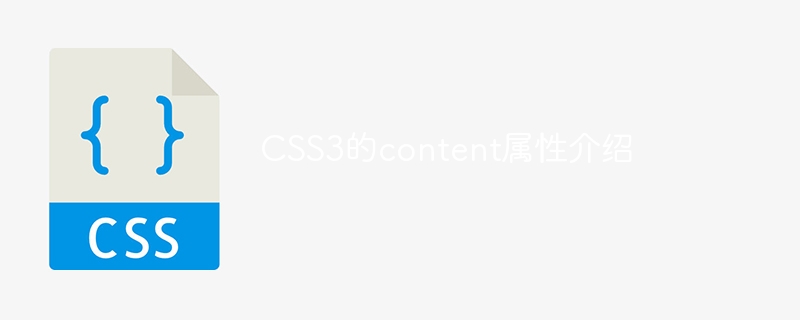Home >Web Front-end >CSS Tutorial >Understand the content attribute in CSS3
Understand the content attribute in CSS3
- 王林Original
- 2024-02-18 21:33:08999browse

Introduction to the content attribute of CSS3 and code examples
In CSS, the content attribute is used to insert content in pseudo-elements (pseudo-elements). Pseudo-elements are special elements in CSS that do not actually exist in the HTML document, but can be selected through CSS selectors and content can be inserted before, after, or inside them.
The content attribute has two main uses: one is to insert text content into pseudo elements, and the other is to insert specific styles of decorative content into pseudo elements. These two uses are introduced below and corresponding code examples are given.
1. Insert text content into pseudo elements
You can use the content attribute to insert custom text content into pseudo elements. It can be ordinary text, special characters or Unicode codes.
Code example:
.content:before {
content: "这是在伪元素:before中插入的文本";
}In the above example, the :before pseudo-element is used to insert a piece of text content before the .content element.
2. Insert specific styles of decorative content into pseudo elements
In addition to inserting text content, we can also use the content attribute to insert some specific styles of decorative content into pseudo elements, such as icons, counts, etc.
Code example:
.pagination:after {
content: "";
display: inline-block;
width: 10px;
height: 10px;
background-color: blue;
border-radius: 50%;
}In the above example, a blue circular icon is inserted after the .pagination element using the :after pseudo-element.
It should be noted that when using the content attribute to insert decorative content, you need to set the display attribute to specify its display mode. Commonly used values are inline, inline-block and block.
In addition to conventional decorative elements, the content attribute can also be used with some CSS3 features to achieve more complex effects.
Code example:
.tooltip:before {
content: attr(data-tooltip);
position: absolute;
top: -20px;
left: 50%;
transform: translateX(-50%);
padding: 5px;
background-color: #333;
color: #fff;
border-radius: 3px;
}In the above example, use the attr() function to obtain the value of the data-tooltip attribute, and use the content attribute to insert a background color and text in front of the .tooltip element. Color tooltip.
It should be noted that the content attribute can only be used in pseudo-elements, and can only be used in :before and :after pseudo-elements.
Summary
Through the above code example, we can see the flexibility of the content attribute, which can insert text content or decorative content of a specific style into pseudo elements. By rationally using the content attribute, you can add more details and personalized effects to the web page.
However, you need to pay attention when using the content attribute:
- The content attribute can only be used in pseudo-elements: before and :after.
- When inserting text content, you need to write it in quotation marks.
- When inserting icons and decorative content, you need to use the display attribute to specify its display mode.
- Can be combined with some CSS3 features to achieve more complex effects, such as using the attr() function to obtain the value of an element attribute.
We hope that the introduction and code examples of this article can help readers better understand and apply the content attribute in CSS3.
The above is the detailed content of Understand the content attribute in CSS3. For more information, please follow other related articles on the PHP Chinese website!

